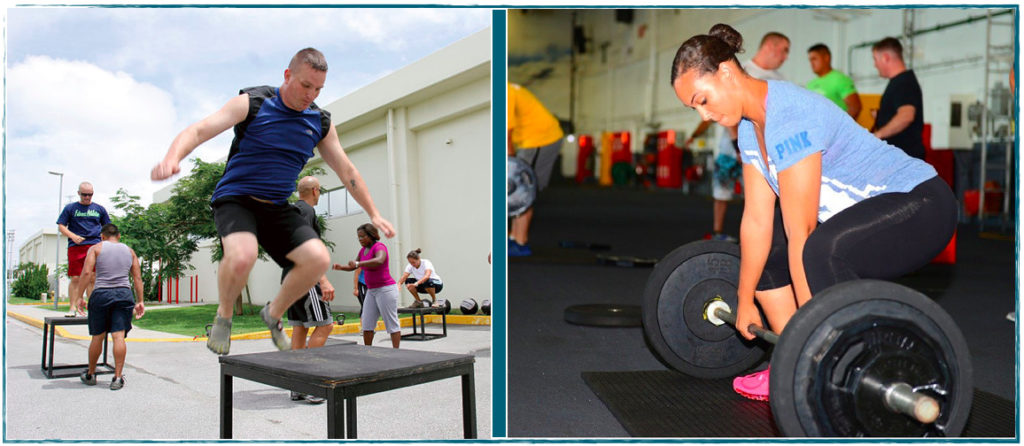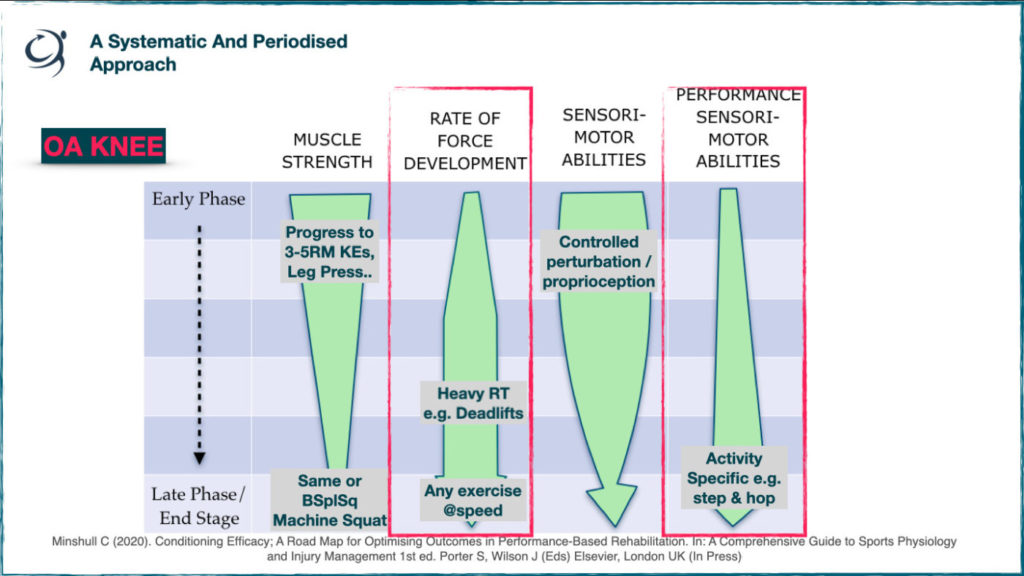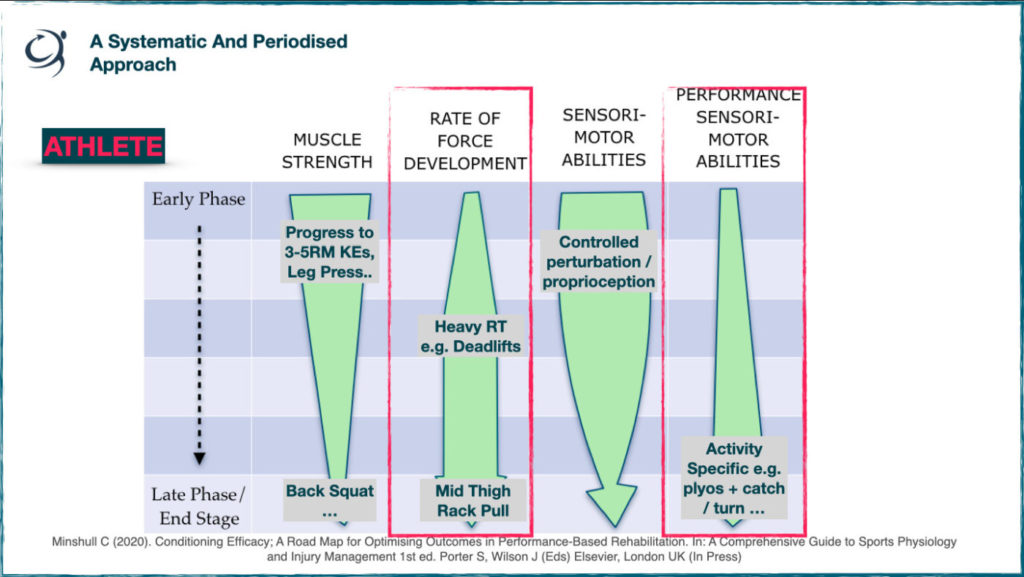Welcome to post 48 of Strength & Conditioning for Therapists and the second in a two-part series on muscle power. Last time we explored rate of force development (RFD), muscle power and the underpinning determinants. This week we’re going to build on that and look at the optimal kinds of exercises for muscle power development.
What Is Muscle Power?
As a reminder, muscle power is a product of strength and speed (or force x velocity). If you remember, RFD is a critical component of muscle power and last time we simplified matters by amalgamating both in the description of ‘speed of muscle force production’.
Exercises For Muscle Power
If the equation for power is force x velocity, in order to train muscle power we should be able to manipulate either of these variables to optimise power development, right? Well almost. We need to be careful that there’s sufficient load to promote adaptation.
Let’s consider the goal of the muscle power training intervention. Often it’s injury related – i.e. to be able to produce a ‘meaningful level’ of muscle force in sufficient time to dynamically stabilise a joint (in response to threatening perturbations), OR it’s performance related, let’s say here it’s to maximise vertical jump height. We know speed is of paramount importance, therefore, could we focus our efforts purely on the velocity side of the equation?
Plyometric Training For Muscle Power
For example, how about jump training to enhance jump performance? In fact, what about plyometrics? The emphasis on plyometric training is the rapid transition from the eccentric (landing) to the concentric (take-off) phase and with ‘explosive’ effort. Given that this is activity specific, and it’s fast, surely it would be effective.
Indeed a meta-analysis [1] showed that plyometric training was effective in improving vertical jump height in young sports people..of around 7-10% pre- to post-intervention. Cool. However…the same meta-analysis also illustrated that Olympic Weightlifting increased vertical jump height by the same amount. Hmmm.

In fact, when we look at the recent literature, there’s a lot of evidence that shows that heavy resistance training can improve RFD, which is a critical component of muscle power. Furthermore, studies have shown that weightlifting derivatives (i.e. parts of the movement that omit the ‘catch’) can elicit the same or greater improvements in muscle power – like the vertical jump, compared to traditional plyometrics [2].
Why might this be …? Well, think about what we’re trying to achieve – fast twitch motor unit activation AND development and expression of high forces. Now consider plyometrics, these are typically bodyweight exercises. Does this provide sufficient overload to promote adaptation of both these component? Perhaps initially, but if we consider the 3 principles of training there’s a risk of plateauing with respect to overload and thus the continued production of positive adaptations Why? Because the load of the exercise remains the same – it’s body weight, well give or take … there’s only so much you can safely increase the height of a plyometric box and add to a weighted vest!
Resistance Training For Muscle Power
This is where heavy resistance training, and indeed Olympic lifting (OL) movements can be useful. One frequently cited exercise in the literature is the Mid Thigh Rack Pull, also called the Mid Thigh Clean Pull. I’ve grabbed a couple of videos from YouTube to illustrate the exercise (see below). Yes, this exercise and other part OL-type exercises can be a bit tricky, however, the really technical part of the lift is omitted – in this example the ‘catch’ phase, so they can usually be accomplished correctly and effectively by experienced trainers … you don’t have to be an expert in Olympic Lifting.
So, where does that leave us? Well, as always, I suggest going back to the goal of the individual patient. What are the activities that they want to return to and what are the performance demands of these activities? Once we understand this, we can then plan and periodise the rehabilitation programme and exercises for muscle power.
For example, a patient with an OA knee might have a very different goal compared to a competitive athlete. As such, the need to specifically focus on power will be different – as long as we ensure we focus on muscle strength adaptation first!
Strength should be perceived as a ‘‘vehicle’’ driving the enhancement of several key performance variables, particularly RFD and power. [3]
Periodisation & Exercise Selection
If you watched my video on end-stage rehab (here), you will have seen the examples of a periodised approach to training and rehabilitation. If you didn’t, I’d encourage you to watch it for a fuller description.
In the below images, focus on the Rate Of Force Development and Performance Sensor-Motor Abilities columns. The larger the arrow the larger the focus of that part of the rehabilitation phase. You can see in the Early phase, a lot of time is spent on muscle strength development and then later there’s a move to develop RFD and Performance Sensor-Motor Abilities, the latter being functional or performance-relevant tasks with an emphasis on speed.
Strength training requires heavy loads and as such you will get some development in RFD and potentially power. It might be that this is sufficient for the OA Knee patient and you don’t require a specific periodised block of power training, you just need to teach that person how to use (or express) the force that they’ve developed in functionally-meaningful situations (Performance Sensor-Motor Abilities).
If you do want to take it further and develop RFD and power, the key to resistance exercises is to perform them explosively – with an intent to lift with maximal speed. For a very sporty person with knee OA who’s accomplished in the gym, perhaps you can introduce exercises for power like compound and explosive lifts, like deadlifts. Or other resistance exercises but performed with lighter weight and at speed.

For the athlete, it’s likely that there will be a greater need to focus on RFD and power. You can programme and with an increased focus on explosive lifting for development of RFD and translate this into performance towards the end stage and return to play. Such exercises for power might include plyometrics, sprinting (+/- load) with and without inclusion of a sport specific skill – like kicking, throwing etc.

Summary
So, RFD is an important component of muscle power. We can and should pay attention to both, whatever the individual’s needs and goals. Whether or not we periodise a specific and extended block of power training into conditioning or rehabilitation may be determined by the individual as well as their initial training status – a good block of proper strength training will likely convey some benefits to power too. You just need to condition the individual how to express, or use it quickly.
Have you registered to be first to hear about the next enrolment on our hugely popular and international online course?
References
- Lesinski et al. Effects and dose–response relationships of resistance training on physical performance in youth athletes: a systematic review and meta-analysis. Br J Sports Med 2016;50:781–795
- Hackett et al. Olympic weightlifting training improves vertical jump height in sports people. Br J Sports Med. 2016;50:865–72
- Suchomel, et al. The importance of muscular strength in athletic performance. Sports Med.2016;46(10):1419–49

